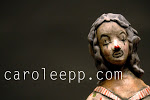emerging artist: Amanda Bury
“As
a maker I rely on the central role of utilitarian objects as vehicles
for nourishment. This role entwines the object in a complex relationship
between human and nature. Eating is the most profound enactment of our
connection to nature, and what we eat determines how the whole planet is
used.
a maker I rely on the central role of utilitarian objects as vehicles
for nourishment. This role entwines the object in a complex relationship
between human and nature. Eating is the most profound enactment of our
connection to nature, and what we eat determines how the whole planet is
used.
I
use utilitarian ceramic objects as a conduit to speak further about
connections and relationships between human beings and the rest of the
natural world. This complex intricate network creates intersections
between culture, ethics, commerce, history, ritual, community and
environment and provides a vast pool from which to be inspired for a
lifetime.
use utilitarian ceramic objects as a conduit to speak further about
connections and relationships between human beings and the rest of the
natural world. This complex intricate network creates intersections
between culture, ethics, commerce, history, ritual, community and
environment and provides a vast pool from which to be inspired for a
lifetime.
Current
work focuses on the idea of nature and thereby food as sacred. Formal
elements and surface treatments often reference nature or sacred
geometry, which has its roots in the study of nature and the
mathematical principles which govern it. There is direct reference to
architectural and decorative elements of sacred spaces such as mosques,
churches or temples. All of these references seek to create the same
reverence for nature and food as one would have within a sacred space.
If we honored and revered nature as sacred, acts of growing, preparing
and consuming food would thus be ritual.
work focuses on the idea of nature and thereby food as sacred. Formal
elements and surface treatments often reference nature or sacred
geometry, which has its roots in the study of nature and the
mathematical principles which govern it. There is direct reference to
architectural and decorative elements of sacred spaces such as mosques,
churches or temples. All of these references seek to create the same
reverence for nature and food as one would have within a sacred space.
If we honored and revered nature as sacred, acts of growing, preparing
and consuming food would thus be ritual.
The
very nature wood firing embodies and reaffirms the ideas of nature,
environment, history, ritual and community held within the work. The
process incorporates experimentation, skillfulness, knowledge and an
intimacy over time. I use wood firing as a way to create natural,
organic surfaces. The atmospheric effects often blur and obscure
intended surface work which mimics the distance and obscurity found in
the connections we have with our nourishment today.” – Amanda Bury
very nature wood firing embodies and reaffirms the ideas of nature,
environment, history, ritual and community held within the work. The
process incorporates experimentation, skillfulness, knowledge and an
intimacy over time. I use wood firing as a way to create natural,
organic surfaces. The atmospheric effects often blur and obscure
intended surface work which mimics the distance and obscurity found in
the connections we have with our nourishment today.” – Amanda Bury



















